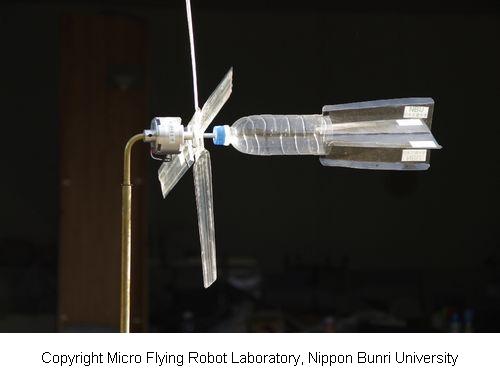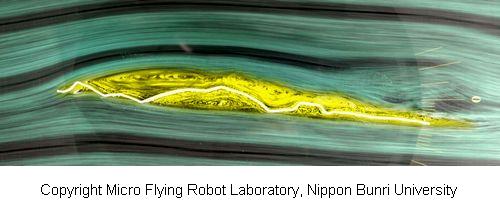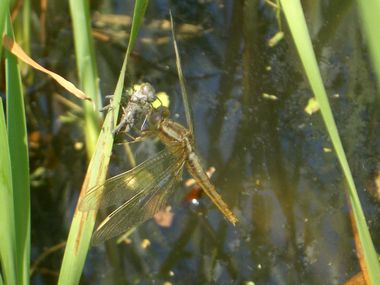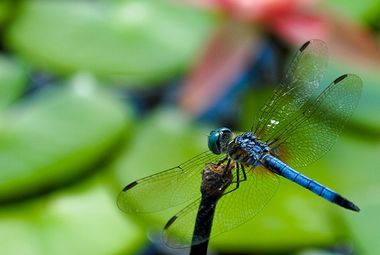February 14, 2012
Dragonfly Wing Design Pioneers the Future -- Development of the Micro Wind Turbine
Keywords: Newsletter
JFS Newsletter No.113 (January 2012)
"JFS's 'Get Inspired by Nature' Project" (No. 4)

When I visited an exhibition about nature-based technology held in Tokyo in November 2011, I spotted a display featuring a micro-sized wind turbine with a diameter of only about 50 centimeters. It had four very thin plastic corrugated blades, and the center of its rotor was made from a plastic bottle. I saw that just by catching a slight breeze the blades were rotating, generating electricity, and illuminating the light-emitting diode (LED) lights connected to the generator.
It turns out that the design of this tiny, toy-sized wind turbine is infused with wisdom learned from the dragonfly's wing structure and mechanisms of flight, and it has the potential to solve some major energy problems facing society. In this issue of the JFS newsletter, we feature an article about this micro wind turbine -- and how it was inspired by the dragonfly and the characteristics and possibilities unique to its design. Here we interview its developer, Professor Akira Obata of Nippon Bunri University.
Micro Flying Robot Laboratory, Nihon Bunri University
http://www.nbu.ac.jp/~mfrl/index_e.html
It was in 2005 when Prof. Obata, who majored in aeronautics, encountered some interesting research on dragonflies. Subsequently, he got involved with a five-year research project titled "Research and Development of an Insect-Type Micro Flying Robot" subsidized by Japan's Ministry of Education, Culture, Sports, Science and Technology. During this time he worked on developing a flying robot that employed the principles of the dragonfly's mechanisms of flight.
As the first step in this research, Prof. Obata's laboratory developed specialized experimental equipment -- the world's first large water tank designed to observe a magnified equivalent of how air would flow around a dragonfly's wings, at rates as slow as dragonfly actually experiences while flying. Applying a principle which allows water to simulate airflow accurately under certain circumstances, this tank enables the visualization of water flow lines and vortices, and helped to discover the principles behind how a dragonfly's wings create lift.
Prof. Obata found that the dragonfly's wing structure held the key to its stable flight. Specifically, it was the fact that its very thin wings, with their corrugated surface, created a series of small vortices above the wing surface while in flight. This was the secret to allowing the wings to create lift by making the vortices flow backward, like on a conveyor belt, and simultaneously reducing air resistance by also sweeping backward any air that is trying to "cling" to the wing.

Based on this research he succeeded in developing a micro-sized flying robot using the dragonfly's wing structure and flight mechanism as an inspiration, but one day one of his friends asked him, "So, can you actually create anything useful with this robot design?" The question intrigued him. He replied, "That's a good point. I will invent something useful using the technologies learned from the dragonfly."
The dragonfly is good at maintaining stable flight even in a slight breeze, So he wondered if he could make use of this ability to keep stable at low speeds as a nature-based technology, taking the opposite of the approach usually followed by industrial society in pursuing high speed and high power. Later on, he came up with the idea of applying the technology to the blades of wind turbines, and after three to four years of trial and error he created the micro wind turbine.
Most large-scale wind turbines in Japan have a mechanism that rotates only with the wind blowing from the same direction at a constant speed, like the ones used in Europe. These turbines do not rotate in light winds, so they are not so suitable for Japan where winds vary dramatically in strength and direction. In fact, this micro wind turbine rotates even when it catches a slight breeze as light as 30 centimeters per second (about 1 kilometer per hour), even with a generator attached.
It also costs a large amount of money to construct sturdy wind turbine structures that can withstand gale force winds such as typhoons. In high winds, the turbine blades curve into a conical shape -- instead of rotating faster -- to adjust to the wind, and this lowers the electricity output automatically. The micro wind turbine can tolerate high winds because of its ability to avoid damage by adjusting its shape, and yet can continue rotating even in a slight breeze, so it is better suited to the variety of wind conditions in Japan.
Many wind turbines in Japan generate electricity using blades that rotate at a high speed to turn a shaft connected to a generator. In contrast, the micro wind turbine rotates efficiently at low speed, and do not make any low-frequency noise, one of the problems with large-scale wind turbines. At the same time, thin plastic plates or even cardboard can be used for micro turbine blades, as well, making it safe for someone to even stop the spinning blades by hand.
Micro wind turbines have many possible applications. For instance, in developed countries they can be used to generate basic household electricity -- at least enough to charge cell phones and batteries -- by installing them on the balconies of apartment buildings. Whereas in countries where blackouts often occur, they can supply basic electricity demands, such as for lighting at night, without the need to construct large-scale power plants or expanding power grids. Prof. Obata intends to conduct more research toward the design's practical use for supplying electricity safely and inexpensively in rural areas.
His research laboratory has two objectives for achieving the practical use and promotion of the micro wind turbine. The first is to achieve a constant output of electricity amounting to up to 20 percent of the actual power of the wind. Although there are challenges getting actual electricity output from a generator, an output of between 15 and 20 percent appears achievable at this time with the speed of 2.5 meters per second (nine kilometers an hour), the average wind speed in Japan. However, if the developers can attain high rotation under the average wind speed and an electrical output of nearly 30 percent of the power of the wind under various conditions on electric loads on the generator, this new invention could be the perfect compact wind turbine, usable by anyone. Prof. Obata says, "I want to review the theory of the wind turbine right from square one, and achieve 30 percent output by combining the latest electricity generation technologies."
Another challenge is production cost. This wind turbine is produced in small numbers at the moment, as the manufacturing process requires time and efforts. When considering mass production, the labor cost could be expensive. Thus, there is no option but to produce it in developing countries with lower labor costs, although, it may be a challenge to maintain high quality and product performance. He still hopes to be able to manufacture the turbines while maintaining high quality at a low cost, even in a country like Japan where labor cost is high, and estimates the manufacturing cost per unit could be kept as low as 10,000 yen (around U.S.$130).
At the end of our interview we asked Prof. Obata for his current thoughts and what he wants to pass on to the younger generation regarding the key philosophy of learning from nature, looking back at his past studies -- specifically when he started to observe dragonflies, then develop a flying robot, and finally created the micro wind turbine.
Reflecting on his past research and inventions, he answered, "Certainly, research based on field work to study nature is important. But I believe also that engineering studies to produce things that mimic natural systems are as important as field studies, and this approach of studying natural systems holds new meaning for science. It will contribute to the development of more environment-friendly things, and is available for anyone, anywhere to try -- regardless of age, sex, or academic background. People get a good feeling about this approach, which makes it easy to attract more and more people. And I've found that this good feeling actually brings us the good fortune of new discoveries."
In the end he left us with this message for younger generations: "Nature is wonderful and gives us much to learn from infinitely. But it does not easily open the doors to its mysteries, nor does it usually tell us even where the doors are. So we need to ask, what can we do to learn from nature? When we keep humbly coming up with questions about the wonders of natural phenomena and observe them, then we can sometimes find those doors."
"From my own experiences, I would say that developing a visualization tool is the key to success. Try to create your own visualization tool to find the doors to answer your questions. Once you find the doors, you will see a new world. Finally, I believe that the idea of learning from nature is highly compatible with the mindset of the Japanese people, and this is one of the things we should pursue."
Epilogue: When we look at nature around us from different perspectives, we might be able to see new possibilities for the future. JFS's "Get Inspired by Nature" project will introduce a broad range of discoveries inspired by nature in Japan and the world. If you have ideas or suggestions, please share them with us.

Image by Japan for Sustainability
Written by Noriko Sakamoto
This project is supported by Hitachi Environment Foundation
See also: JFS "Get Inspired by Nature" Project
Related
"JFS Newsletter"
- 'Good Companies in Japan' (Article No.4): 'Eightfold Satisfaction' Management for Everyone's Happiness
- "Nai-Mono-Wa-Nai": Ama Town's Concept of Sufficiency and Message to the World
- 'Yumekaze' Wind Turbine Project Connects Metro Consumers and Regional Producers: Seikatsu Club Consumers' Co-operative
- Shaping Japan's Energy toward 2050 Participating in the Round Table for Studying Energy Situations
- 'Good Companies in Japan' (Article No.3): Seeking Ways to Develop Societal Contribution along with Core Businesses



